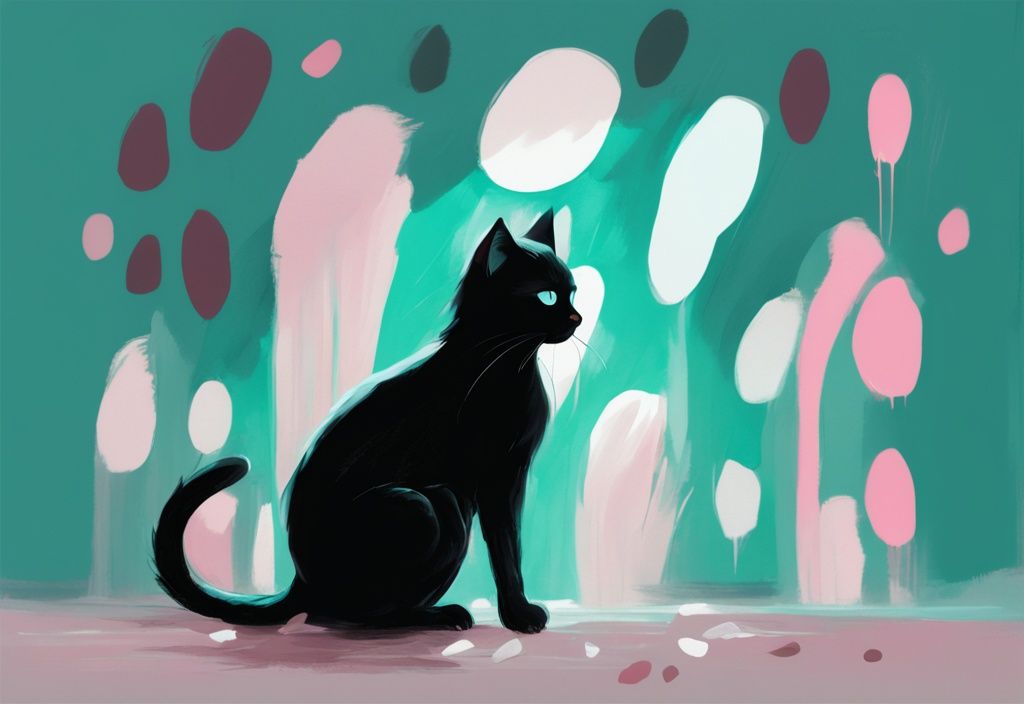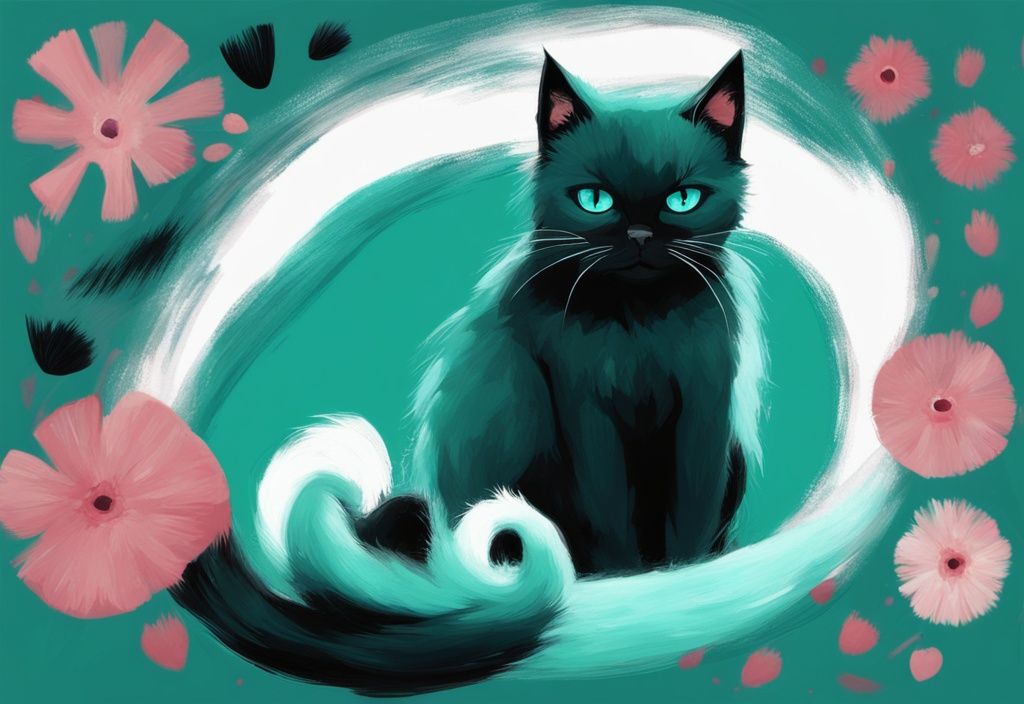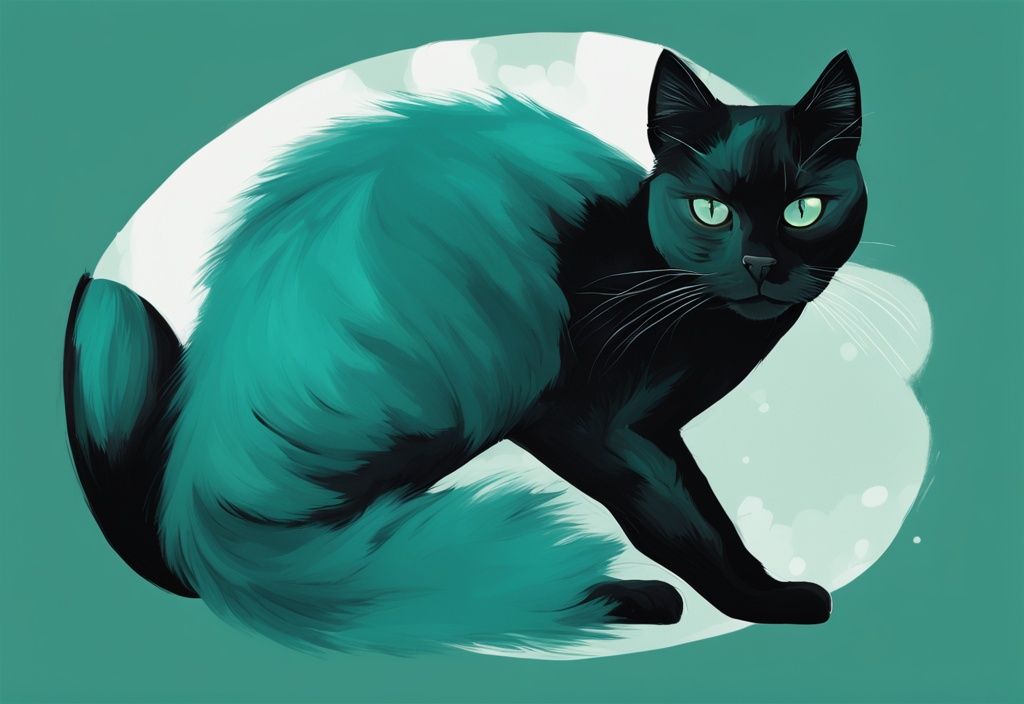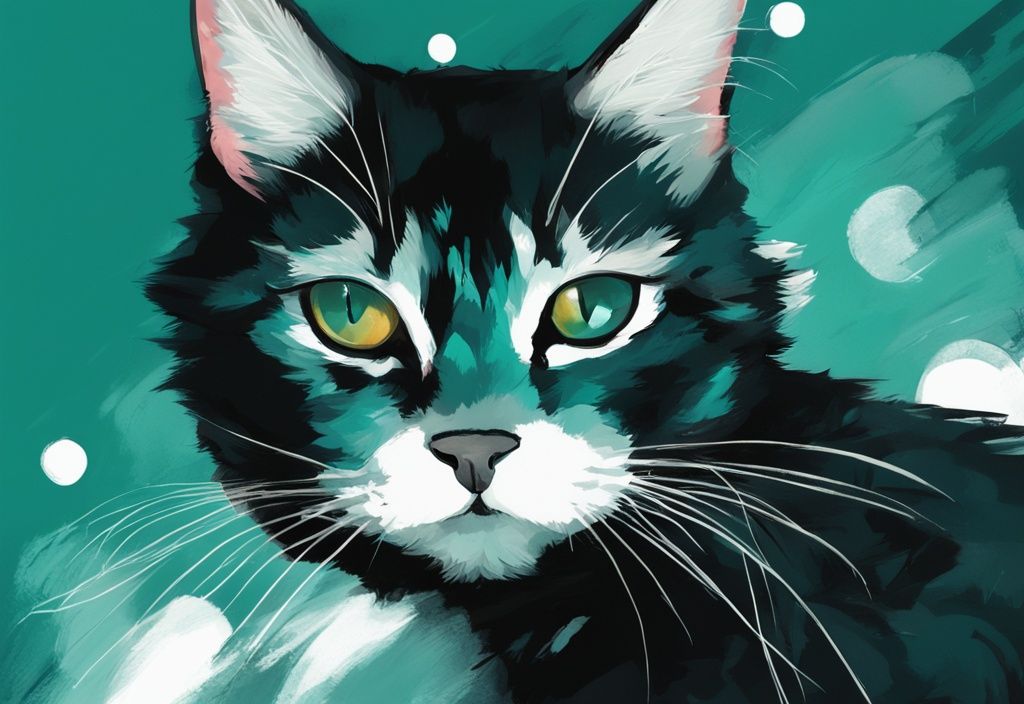“Wait a minute, Whiskers, were you always this…white?” If you’ve found yourself asking this question about your once-black cat, you’re not alone. It’s a curious phenomenon that has left many cat parents, including myself, scratching their heads. But don’t fret, it’s not as alarming as it seems!
In this fur-tastic article, we’ll delve into the common causes behind your black cat’s surprising transformation. From natural aging processes to sneaky genetic factors, we’ll uncover the reasons why your feline friend might be changing colors.
By the end of our little adventure, you’ll have a clearer understanding of this fur color mystery. Plus, you’ll pick up some handy tips to ensure your cat stays as healthy and happy as my Whiskers, regardless of their coat color!
Understanding Why Your Black Cat’s Fur Is Turning White
Ever caught yourself wondering, “Why is my black cat turning white?” You’re not alone! It’s a curious transformation that many cat owners notice, and it can be quite the head-scratcher. Let’s dive into the fascinating world of feline fur color changes and uncover the mysteries behind your cat’s new look.
The Role of Aging in Fur Color Change
As your black cat ages, you might notice a gradual shift in its fur color. This change is primarily due to a decrease in melanin production—the pigment responsible for maintaining that rich, midnight hue of your cat’s coat. As melanin levels drop naturally with age, it’s common for black cats to develop white or grey hairs. Think of it as your cat’s version of distinguished silver streaks! This transition is a natural part of aging and typically doesn’t indicate any underlying health issues. Embracing this change can be a beautiful reminder of the years you’ve shared with your feline companion. After all, every white hair is a testament to the cuddles and purrs you’ve enjoyed together.
How Genetics and Breed Characteristics Influence Fur Color
Genetics play a significant role in determining why your black cat’s fur might be turning white. Certain breeds are genetically predisposed to changes in fur color as they age. It’s like how some people go grey earlier than others—it’s all in the genes! Specific genes can influence the lightening of fur, making some cats more susceptible to this transformation. While these genetic factors might alter your cat’s appearance, they are usually harmless as long as your pet remains healthy. Understanding the genetic makeup of your cat can provide insights into these changes, helping you appreciate the unique characteristics that make your feline friend special. Isn’t it wonderful how each cat has its own story written in its fur?
Health and Environmental Factors Affecting Your Cat’s Fur Color
Ever noticed your sleek black cat turning into a patchy tuxedo? Let’s dive into the reasons behind this magical transformation. From what goes into their food bowls to the sunlit spots they love to nap in, several factors can cause your feline friend’s fur to change color. Understanding these elements can help you keep your kitty’s coat as vibrant as their personality.
Nutritional Deficiencies and Their Impact on Fur Color
Have you ever caught yourself asking, “why is my black cat turning white?” Well, one culprit could be nutritional deficiencies. Imagine if your cat’s diet were a jigsaw puzzle, and a few pieces were missing. Without the right nutrients, your cat’s fur might start to lose its rich, dark hue, much like a fading photograph. This can sometimes come with other signs like a lack of energy or a coat that’s not as glossy as it used to be.
Ensuring your cat gets a balanced diet is like giving them the keys to a vibrant, healthy life. Think of it as fueling their little engines with premium gasoline. Regular vet visits can help spot any nutritional gaps, ensuring your cat’s fur remains as stunning as ever. After all, who doesn’t want their feline to look like the star of the catwalk?
Effects of Sun Exposure and Stress on Your Cat’s Fur
Now, let’s talk about the sun, that big, fiery ball in the sky. It’s not just for warming up Whiskers’ favorite nap spot. Prolonged sun exposure can actually bleach your cat’s fur, turning that midnight black into a softer shade. Outdoor cats, in particular, might find themselves with a sun-kissed look after lounging in the sun too long.
And then there’s stress. While it’s less common, stress can play a sneaky role in changing fur color. It’s like when we humans get a few gray hairs during a hectic week. To keep these effects at bay, try creating a shaded oasis for your cat and a stress-free environment. A happy cat is a colorful cat, after all!

By understanding these environmental influences, you can help your cat maintain their natural fur color, ensuring they remain the sleek, mysterious companion you know and love.
Medical Conditions Causing Fur Color Change in Cats
Ever noticed your black cat turning into a dappled masterpiece of white patches? You’re not alone! Let’s explore some medical conditions that might be behind this magical transformation. From depigmentation to vitiligo, we’ll dive into what could be causing your feline friend’s fur to change color.
Depigmentation in Cats: Causes, Symptoms, and Treatments
Depigmentation in cats can be quite the head-scratcher! Imagine my surprise when Whiskers, my cuddly rescue cat, started sporting a lighter coat. If you’re asking, “why is my black cat turning white?” depigmentation might be the culprit. This condition can be triggered by genetic quirks, autoimmune disorders, or even environmental factors.
Does your cat have a new look around the eyes or a nose that’s changing color? Maybe some skin crusting? These could be signs of depigmentation. Veterinarians often play detective with blood tests, skin biopsies, and other checks to get to the root of the issue. Treatments vary, but they might include medications or hormone therapies to keep your kitty feeling fabulous.
Vitiligo in Cats: What You Need to Know
Vitiligo might sound like a fancy Italian dish, but it’s actually a condition that could explain why your black cat is turning white. This rare disorder causes fur to lose its color in patches, creating a unique pattern. While the exact cause is still a mystery, it’s mostly a cosmetic change and doesn’t bother your cat one bit.
Think of it as your cat’s way of getting a new look without a trip to the salon! It’s important to keep an eye on these changes and have a chat with your vet to ensure it’s just a cosmetic quirk and nothing more. Remember, your feline’s health is the top priority, even if their fur is pulling a disappearing act!
When to Seek Veterinary Help
Ever wondered why your black cat is suddenly sporting a white coat? While it might seem like a magical transformation, it’s important to know when this change could be a sign of something more serious. Let’s dive into the world of feline fur and figure out when it’s time to call in the pros!
Recognizing Warning Signs of Serious Health Issues
So, your sleek black kitty is turning into a snowball overnight? It’s not just a fashion statement! If this color change is sudden or covers large areas, it’s time to keep an eye out for other clues. Is your feline friend skipping meals, having tummy troubles, or acting out of sorts? These could be whispers of an underlying health issue that needs a vet’s attention.
Regular vet visits are like a spa day for your cat’s health—preventive care at its finest! These check-ups help catch any sneaky problems early on, ensuring that your cat’s new white fur isn’t hiding a bigger issue. If your cat’s fur is turning white and you’re spotting other worrisome signs, don’t wait! A vet can perform a thorough check-up, run some tests, and get to the root of the problem. After all, a happy cat means a happy home, right?

Preventing Fur Color Change in Your Black Cat
Ever wondered why your gorgeous black cat is suddenly sporting some white fur? Let’s dive into some playful yet practical ways to keep that coat as dark as a moonless night. From diet tweaks to grooming rituals, there’s a lot you can do to maintain that sleek, shadowy look.
Importance of a Balanced Diet and Regular Grooming
Did you know that what your cat eats can actually affect their fur color? Just like how my Border Collie, Max, gets extra bouncy with the right snacks, your cat’s diet plays a crucial role in keeping their fur dark and glossy. A balanced diet rich in essential vitamins and minerals supports melanin production—the magic behind that deep, dark fur.
And let’s not forget about grooming! Regular grooming isn’t just about keeping your cat looking fabulous. It’s like a spa day for Whiskers, my cuddly rescue cat, where natural oils get distributed throughout the coat, keeping it healthy and vibrant. Plus, it’s a great way to spot any changes early on. Who doesn’t love a bit of pampering?
Oh, and here’s a nugget of wisdom: routine vet visits are a must! These check-ups can catch any sneaky health issues that might be causing your cat’s fur to lighten. Vets can offer tailored advice on diet and grooming, ensuring your feline friend’s coat stays as dark and lustrous as possible. By focusing on these preventive measures, you can better understand why your black cat’s fur might be turning white and take proactive steps to maintain their beautiful coat.
FAQ
Can stress cause my black cat’s fur to turn white?
Oh, the mysteries of feline fur! While it might seem like stress could turn your black cat’s coat into a snowy wonderland, it’s actually quite rare. Stress can tinker with hormonal balance, but the effect on fur color is usually as subtle as a whisper. For those concerned about pet health, you might also wonder what diseases you can catch from your dog. So, if Whiskers is feeling a bit anxious, a cozy cuddle might do the trick instead of worrying about a color change.
Is it normal for black cats to develop white hairs as they age?
Absolutely, and it’s as natural as my Border Collie, Max, chasing his tail! As black cats age, they might start sporting a few distinguished white or grey hairs. This is due to decreased melanin production, much like how we humans find a few silver strands as the years roll by. It’s all part of the beautiful aging process!
Should I be concerned if my black cat’s fur is turning white?
Generally, a little color change is nothing to fret over, especially if your cat is purring happily and showing no other signs of distress. However, if the transformation is as sudden as a lightning bolt or paired with other symptoms, a visit to the vet is a wise move. Better safe than sorry, right?
How can I prevent my black cat’s fur from changing color?
While you can’t stop time, you can help maintain that sleek black coat with a few simple steps:
- Provide a balanced diet to keep your cat’s fur as shiny as a new penny.
- Regular grooming sessions can be a fun bonding time, much like Max and I enjoy.
- Keep your kitty out of the sun’s harsh rays, unless they’re channeling their inner sunbather.
- And don’t forget those regular vet check-ups to ensure overall fur health!

Remember, a little love and care can go a long way in keeping your feline friend looking fabulous!
Conclusion
Ever found yourself scratching your head and asking, “Why is my black cat turning white?” Well, you’re not alone! This curious change in fur color can be quite the head-scratcher, but fear not—it’s usually nothing to worry about.
Let’s dive into the delightful world of feline fur! Just like how our hair might get a few silver strands as we age, cats can experience a similar transformation. As our furry friends grow older, their bodies might produce less melanin, the pigment responsible for that sleek black coat. So, if your black cat is starting to sport a few white hairs, it’s probably just a sign of graceful aging.
But wait, there’s more! Genetics can also play a sneaky role in this color change. Some cats are simply wired to develop white or grey hairs as they mature. It’s like a surprise gift from their ancestors!
And let’s not forget about the sun—our feline pals love basking in it, but prolonged exposure can sometimes bleach their fur a bit. So, if Whiskers has been enjoying too many sunny naps, that could be a factor too.
While these changes are generally harmless, it’s always a good idea to keep an eye on your kitty’s health. Regular vet check-ups can ensure that these color shifts aren’t signaling any underlying issues.
By understanding the reasons behind why your black cat might be turning white, you can enjoy the journey without unnecessary worries. After all, our pets bring us so much joy, and a little fur color change is just another chapter in their unique stories!
